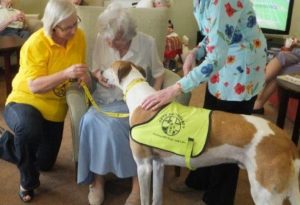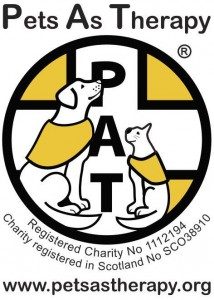Could Your Dog Become a Therapy Dog?
Therapy dogs can be any size and any breed of dog – from a tiny Yorkshire terrier, to an Irish Wolfhound. What counts, is whether they are in suitable health and have the correct temperament for therapy dog activities. There are a range of roles that therapy dogs can be considered for – from visiting elderly people in care homes, to helping children to read in schools.
It is a very worthwhile volunteering path to take, if you have a few hours to spare and a suitable four-legged companion to help you. If you are interested in applying to become a volunteer therapy dog handler Holidays4Dogs provides some information on how to go about it.
In the UK, therapy dogs differ from assistance dogs, in that they are considered to benefit people therapeutically in a broad range of settings. Registered assistance dogs, on the other hand, are trained to carry out specific tasks for a disabled person. Assistance dogs are generally trained professionally by one of the organisations registered with Assistance Dogs UK. These include; Guide Dogs for the Blind and Hearing Dogs for the Deaf.
In addition, a registered assistance dog is allowed to accompany their owners everywhere, including shops, public transport etc. Therapy dogs, as yet, do not have the same legal benefits.
Where do I find out more and where can I get my dog’s temperament tested?
The best place to start is to get in touch with a registered charitable organisation – the largest being Pets As Therapy (or PAT dogs). A new charity named Therapy Dogs Nationwide started in 2016 and similarly works with volunteers and their temperament-tested dogs.
temperament-tested dogs.
To apply, you must have owned your dog for at least six months and he, or she, must be aged nine months, or more. All dogs must pass a temperament test to make sure they are friendly with all sorts of people. They must be happy to be petted and not spooked by novel situations.
Your dog must be calm and well-behaved, and walk nicely on a loose lead (no jumping up!).
You can apply to the organisation by requesting an application form and returning it. If your paper application is successful, you will have a home visit from an assessor.
Your dog must have up-to-date vaccinations and flea treatments. You will also need to supply the names and addresses of two people who can provide references for you. To assist with the costs involved, an annual subscription is requested.
How might my dog fail the temperament test?
It is vitally important that your dog is calm and well-behaved while visiting vulnerable, or sick people. If your dog displays any of the characteristics below, he will be ‘deferred’. If you can address the issue satisfactorily, you can re-apply in another 6 months. Otherwise, your dog will not be suitable for a PAT dog role.
This doesn’t mean he is a bad dog, but assessors must abide by strict criteria as the dogs must be able to behave in predictable ways, in sometimes, unpredictable situations. The main reasons why dogs are rejected are;
- Jumping up – this behaviour could potentially cause injury by knocking over an elderly person, for example.
- Pawing, putting up one, or both paws – again, this can cause injury, particularly to older people with delicate skin.
- Backing away when being petted – any dog that displays a reluctance to be patted, or shows signs of anxiety, will not be passed.
- Barking/Growling – obviously, this sort of behaviour could be seen as quite threatening to old people, or children
- Mouthing/Licking – again this can cause potential injury and licking is not accepted on hygiene grounds.
- Snatching food – anything that involves teeth-to-skin contact, including snatching titbits, would likewise be unacceptable.
What happens if I am accepted? How much time will I need to allocate?
If you and your dog are accepted onto the PAT team you will be allocated with an establishment which is close to your home and convenient for you to get to. There is no set requirement for how often you need to attend visits. However, regular visits – usually for no more than an hour each time – are always very much appreciated.
What sort of role could my dog and I volunteer for?
There are different areas where therapy dogs can be of great benefit. For the elderly who live in care homes and are no longer able to  look after a pet of their own, the opportunity to interact with a PAT dog can bring a great deal of comfort and happiness.
look after a pet of their own, the opportunity to interact with a PAT dog can bring a great deal of comfort and happiness.
Where children and adults are in hospital with diseases such as cancer, a visit from a therapy dog can help to lift spirits – even for those who are not especially dog lovers.
There are other areas where PAT dogs can be of benefit, such as stroke rehabilitation and mental health support. Therapy Dogs Nationwide also operates prison visits.
One of the newer innovations is therapy dogs who work with children in the classroom, by helping them to read. PAT dogs can also help with children with emotional, or behavioural needs, by boosting self-esteem and confidence.
For dog lovers, employing your dog in a therapy role can be extremely rewarding. All temperament-tested dogs love their work and it is a great way to give back to the community.
If you are inspired to become a volunteer with Pets as Therapy, here is the link for further information and the application form.



